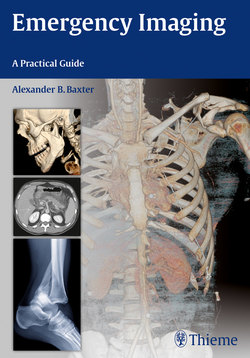Читать книгу Emergency Imaging - Alexander B. Baxter - Страница 115
На сайте Литреса книга снята с продажи.
Оглавление103
3 Head and Neck
or hemorrhage, lens subluxation, intraocu-lar foreign bodies, and traumatic cataract.
Orbital hematomas are caused by pen-etrating or blunt orbital trauma. Blood col-lections within the orbit cause increased intraorbital pressure, which, if not recog-nized and treated, can lead to compressive optic nerve injury. Retrobulbar hemato-mas, in particular, have the potential to compress the optic nerve. The clinical pre-sentation is variable, and symptoms related to hematoma formation may not manifest until several days after the acute injury.
CT identifies proptosis, stretching of the optic nerve, and “globe tenting,” in which the angle made by two tangents to the globe that intersect at the optic nerve head is less than 130°. While orbital hemorrhage and hematoma are uncommon, traumatic orbital compartment syndrome can lead to vision loss; in such cases prompt lateral canthotomy and cantholysis may prevent blindness (Fig. 3.9).
◆ Globe and Orbital Soft Tissue Injury
Open globe injury is a consequence of directocular trauma in which the sclera is disruptedand vitreous humor leaks into the adjacentorbital tissue. Although ophthalmoscopy ismore sensitive for detection of small rup-tures, it is not always possible to examine theglobe in acute facial trauma due to periorbit-al soft tissue swelling, and globe rupture isoften identified on CT for face or head injury. The ruptured globe is often small and irregu-lar and can have a flattened contour remi-niscent of a “mushroom” or “flat tire.” Globe rupture may follow either blunt or penetrat-ing trauma. In blunt trauma, it frequently oc-curs at intraocular muscle insertions, wherethe sclera is thinnest.
Some globe ruptures are inapparent on CT. In patients with an apparently intact globe, unilateral posterior lens subluxation (deep anterior chamber) or thickening of the posterior sclera are subtle signs of globe injury. More obvious CT findings in-clude scleral discontinuity, intraocular air
Fig. 3.9a–fa,b Globe rupture with intraocular lens prosthesis extrusion. Extensive right-sided preseptal periorbital hematoma. The right globe is distorted with a mushroom-like appearance. A tiny linear density superolat-eral to the anterior globe is an extruded intraocular lens implant.
c Globe rupture. Globe deformity with posterior attening and reduced volume. The lens is displaced from its normal position.
d Globe rupture with vitreous hemorrhage from drill-bit perforation. Flattened anterior globe, intravitre-ous hemorrhage, and posterior vitreous versus choroidal hemorrhage.
e,f Intraorbital hematoma. Right intraconal and retrobulbar soft tissue stranding with associated mild proptosis.
